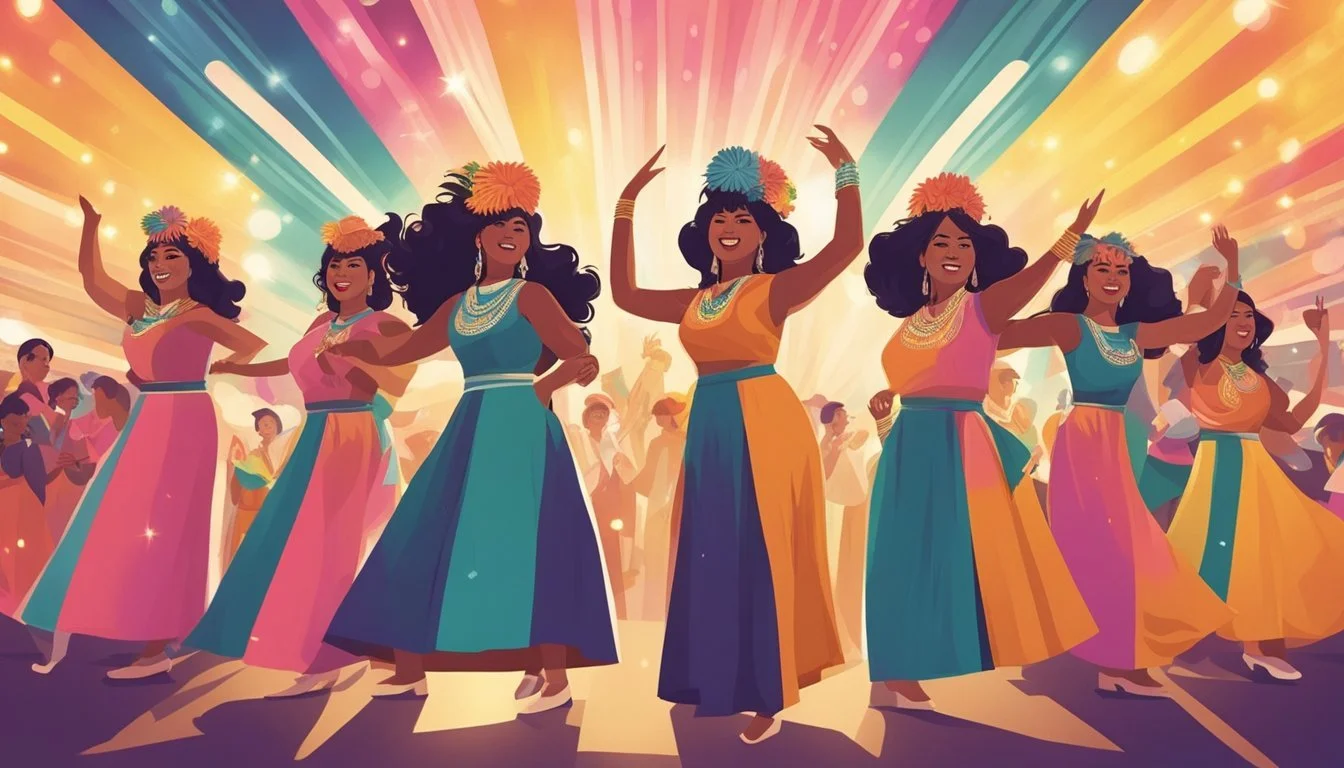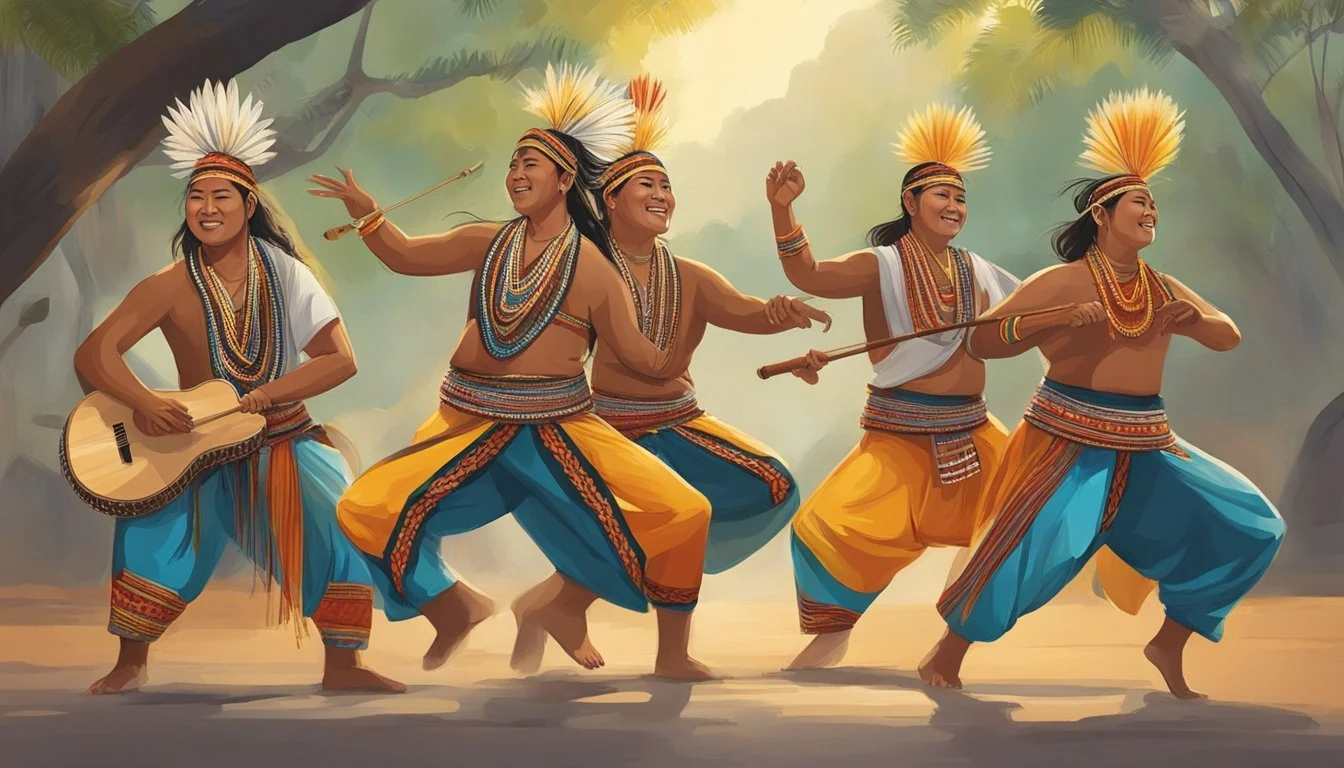The Real Sapphires: Aboriginal Soul in Vietnam
Untold Story of Indigenous Australian Singers During War
The Sapphires, an all-Aboriginal girl group from Australia, made waves in the 1960s with their soulful performances for U.S. troops in Vietnam. Their remarkable journey from a small town to the war-torn stages of Southeast Asia became the inspiration for a hit film in 2012. These talented young women showcased Aboriginal culture and music on an international stage during a pivotal time in history.
The true story behind The Sapphires highlights the often-overlooked contributions of Indigenous Australians to the entertainment industry and the Vietnam War effort. Four Aboriginal singers formed the group, leaving their homes to bring soul music to American soldiers fighting overseas. Their experiences shed light on the complexities of race relations, cultural identity, and the power of music to transcend boundaries.
The Sapphires' tale resonates beyond its historical context, offering insights into the resilience and artistry of Aboriginal people. Their success challenged stereotypes and paved the way for greater recognition of Indigenous talent in Australia and abroad. The film adaptation of their story brought renewed attention to this important chapter in Australian music history, introducing a new generation to the sounds of Aboriginal soul.
Historical Context
The story of The Sapphires intersects with two significant historical events: Australia's complex Aboriginal history and the Vietnam War. These contexts shaped the experiences of Aboriginal women performers during a tumultuous period.
Australia's Aboriginal History
Aboriginal Australians faced systemic discrimination and oppression for much of the 20th century. The Stolen Generation policy forcibly removed Aboriginal children from their families from 1910 to 1970. This traumatic practice aimed to assimilate Aboriginal people into white society.
In the 1960s, Aboriginal rights movements gained momentum. The 1967 referendum granted full citizenship to Aboriginal people. Despite progress, many Aboriginal communities still struggled with poverty and lack of opportunities.
Music provided an important cultural outlet. Aboriginal singers drew inspiration from American soul and R&B, adapting these styles to tell their own stories.
The Vietnam War
The Vietnam War deeply impacted Australia from 1962 to 1975. Over 60,000 Australians served, with 521 killed and 3,000 wounded. The conflict was highly controversial, sparking anti-war protests.
For Aboriginal performers, entertaining troops in Vietnam offered a rare opportunity for international travel and recognition. It also exposed them to the realities of war and American culture.
The war created demand for Western entertainers in Vietnam. Soul music, with its themes of struggle and resilience, resonated with soldiers and performers alike.
Origins of 'The Sapphires'
The Sapphires originated from a real-life Aboriginal girl group in Australia during the 1960s. Their journey from local performances to entertaining troops in Vietnam became the inspiration for a successful stage play and film.
Real-Life Inspirations
The original Sapphires were formed by Aboriginal women Laurel Robinson and Naomi Mayers, along with their cousins. These talented singers faced racial prejudice in 1960s Australia but persevered to showcase their musical abilities.
The group's repertoire consisted mainly of soul classics, drawing comparisons to The Supremes. Their most notable achievement was performing for American troops in Vietnam during the war in 1968.
Evolution into a Film
Tony Briggs, Laurel Robinson's son, wrote a play based on his mother's experiences with The Sapphires. This stage production later evolved into a screenplay for the 2012 film adaptation.
The movie portrays four Aboriginal women who form a soul group and travel to Vietnam to entertain U.S. troops. While taking some creative liberties, it remains true to the essence of the original Sapphires' story.
The film became the most successful Australian production of 2012. It gained international recognition, premiering at the Cannes Film Festival and receiving positive reviews for its upbeat narrative and exploration of Australia's complex racial history.
Cultural Significance
The Sapphires' story highlights the intersection of Aboriginal culture, soul music, and the Vietnam War era. Their journey represents a pivotal moment in Australian cultural history, challenging stereotypes and showcasing Aboriginal talent on an international stage.
Aboriginal Representation in Media
"The Sapphires" film brought unprecedented visibility to Aboriginal performers in mainstream Australian cinema. It showcased Aboriginal women as talented, ambitious, and multifaceted individuals. The movie's success opened doors for more diverse storytelling in Australian media.
The film's portrayal of Aboriginal characters as protagonists rather than secondary roles marked a significant shift. It presented a narrative of Aboriginal empowerment and achievement, countering negative stereotypes often seen in earlier media representations.
Impact of 'The Sapphires' on Community Empowerment
The success of "The Sapphires" inspired pride within Aboriginal communities across Australia. It demonstrated that Aboriginal stories could resonate with wide audiences, both domestically and internationally.
The film's depiction of young Aboriginal women pursuing their dreams in the face of racism and social barriers served as a powerful motivator. It encouraged Aboriginal youth to embrace their cultural identity while pursuing their aspirations.
"The Sapphires" also sparked conversations about historical injustices faced by Aboriginal people. It shed light on the complexities of Aboriginal experiences during the 1960s, including the impacts of discriminatory policies and the Vietnam War on Aboriginal communities.
Film Production
The production of "The Sapphires" brought the story of Aboriginal soul singers in Vietnam to life through meticulous casting and authentic location choices. Director Wayne Blair oversaw a process that balanced historical accuracy with cinematic storytelling.
Casting and Characterization
Jessica Mauboy, Deborah Mailman, Miranda Tapsell, and Shari Sebbens were cast as the four members of The Sapphires. The casting process began in 2010, focusing on finding actresses who could capture the essence of the original singers. Mailman, an experienced actress, brought depth to her role as the group's eldest member. Mauboy, with her background in music, provided authentic vocal performances. Tapsell and Sebbens rounded out the quartet, each bringing unique qualities to their characters.
The actors underwent extensive preparation, including vocal training and studying the historical context of the 1960s. This attention to detail helped create believable portrayals of young Aboriginal women navigating both personal growth and societal changes.
Shooting Locations and Set Design
Filming took place in August and September 2011, primarily in and around Albury, Australia, and Ho Chi Minh City, Vietnam. The Australian Outback served as a backdrop for scenes depicting the singers' origins, capturing the stark beauty and challenges of rural life. Set designers meticulously recreated 1960s Australia, paying close attention to period-accurate details in costumes, vehicles, and buildings.
In Vietnam, the production team transformed parts of Ho Chi Minh City (formerly Saigon) to reflect its 1960s appearance. This included dressing streets with vintage signs and vehicles. The Vietnamese locations provided authenticity to the wartime scenes, allowing the film to convey the tension and excitement of performing in a conflict zone.
Musical Journey
The Sapphires' musical journey blended soul music with their Aboriginal heritage, creating a unique sound that resonated with troops in Vietnam. Their performances and song choices reflected the cultural and social climate of the 1960s.
The Significance of Soul
Soul music played a crucial role in The Sapphires' success. The genre's emotional depth and powerful vocals aligned perfectly with the group's talents. Soul's roots in African American culture resonated with the Aboriginal singers, who found parallels in their own experiences of marginalization.
The Sapphires embraced soul classics, interpreting them with their distinctive harmonies. Their song choices often carried messages of empowerment and unity, which held special meaning for both the performers and their audience.
Musical Performances and Soundtrack
The Sapphires' live shows in Vietnam were electrifying. Their setlists featured popular soul hits and Motown classics that boosted troop morale. The group's harmonies and stage presence captivated audiences, offering a brief escape from the harsh realities of war.
Key songs in their repertoire included "I'll Take You There" and "What a Man." These tracks showcased the group's vocal range and ability to connect with listeners. The Sapphires' performances often incorporated elements of their Aboriginal culture, creating a unique fusion of soul and indigenous sounds.
Their musical journey was later immortalized in the film's soundtrack, which captured the energy and emotion of their original performances. The soundtrack introduced a new generation to The Sapphires' music and the power of soul.
Reception and Legacy
The Sapphires garnered critical acclaim and left a lasting impact on the entertainment industry. Their story inspired various creative works and shed light on Aboriginal experiences during the Vietnam War era.
Critical Acclaim and Awards
The Sapphires film premiered at the 2012 Cannes Film Festival, receiving a standing ovation. It won multiple awards, including 11 AACTA Awards in Australia. The movie's success extended internationally, with positive reviews from critics in the UK and US.
Chris O'Dowd's performance as the band's manager drew particular praise. The film's portrayal of Aboriginal culture and the Vietnam War context resonated with audiences worldwide.
In Canada, CBC highlighted The Sapphires as a breakthrough in Indigenous representation on screen.
The Sapphires' Influence on Contemporary Works
The Sapphires' story inspired a wave of creative projects. Tony Briggs, son of original member Laurel Robinson, wrote a play based on the group's experiences. This later became the screenplay for the film.
The band's journey encouraged more diverse storytelling in Australian cinema. It prompted discussions about Aboriginal representation in media and the entertainment industry.
Several documentaries and books explored the real-life experiences of Aboriginal performers during the Vietnam War era. The Sapphires' legacy continues to influence music and film in Australia and beyond.
Themes and Analysis
The Sapphires explores profound themes of identity, racism, and the unifying power of music against the backdrop of the Vietnam War. It delves into the complex experiences of Aboriginal women navigating a white-dominated society while finding their voice through soul music.
Exploring Race and Identity
The film tackles racism head-on, portraying the discrimination faced by Aboriginal people in 1960s Australia. The Sapphires confront prejudice both at home and abroad, challenging stereotypes through their talent and determination. Their journey highlights the strength and resilience of Aboriginal culture in the face of systemic oppression.
The characters grapple with their identities as Aboriginal women in a changing world. This struggle is exemplified by Kay, who was taken from her family as part of the Stolen Generations. Her reconnection with her roots through music and family bonds forms a poignant subplot.
The Power of Music and Unity
Soul music serves as a catalyst for personal growth and cultural exchange in The Sapphires. The genre's roots in African American struggles resonate with the Aboriginal singers, creating a powerful connection across continents. Their performances for American troops in Vietnam showcase music's ability to bridge cultural divides.
The film emphasizes how music strengthens the bonds between the four women. Their harmonies on stage reflect the unity they find in facing adversity together. This theme of solidarity extends to their interactions with their Irish manager and the American soldiers, illustrating how shared experiences can overcome racial barriers.
Global Impact
The Sapphires' story resonated far beyond Australia's borders, captivating international audiences and shining a light on Aboriginal culture. Their journey from rural Victoria to Vietnam's war zones exemplified the power of music to transcend cultural and geographical boundaries.
International Release and Distribution
The Sapphires film secured a major distribution deal, propelling the story to global screens. It premiered at the prestigious Cannes Film Festival, earning a 10-minute standing ovation. The movie's success in France led to wider European distribution, including a notable release in the U.K.
In the United States, the film received critical acclaim and modest box office success. Its portrayal of Aboriginal performers entertaining U.S. troops in Vietnam struck a chord with American audiences.
The international release brought attention to Indigenous Australian talent and stories, opening doors for future collaborations and cultural exchanges in the entertainment industry.
The Sapphires as Cultural Ambassadors
The real-life Sapphires became unintentional cultural ambassadors during their time in Vietnam. Their performances for U.S. troops showcased Aboriginal talent and resilience on an international stage.
The film's global reach amplified this cultural exchange decades later. It introduced audiences worldwide to aspects of Aboriginal history and culture, fostering greater understanding and appreciation.
Red carpet appearances at international film festivals further elevated The Sapphires' role as cultural representatives. Their story highlighted the universal language of music and its power to bridge divides during times of conflict.
Behind the Scenes
The making of "The Sapphires" involved a dedicated production team and talented cast bringing the story to life. Key figures like director Wayne Blair and the lead actresses played crucial roles in shaping the film's authenticity and impact.
The Filmmaking Process
Wayne Blair directed "The Sapphires" with a focus on honoring the true story behind the film. The production took inspiration from Tony Briggs' play of the same name, which debuted in 2004. Briggs, whose mother was one of the original Sapphires, adapted the play into a screenplay.
The filmmakers aimed to capture the essence of 1960s Australia and Vietnam. They meticulously recreated period costumes and sets to transport viewers to that era. The production team faced challenges in accurately portraying both the Aboriginal mission community and war-torn Vietnam.
Music played a central role in the film. The crew worked to blend soul classics with original compositions, creating a soundtrack that reflected the Sapphires' journey and the era's musical landscape.
Insights from Cast and Crew
The actresses portraying the Sapphires underwent extensive preparation for their roles. They received vocal training to perform the soul numbers convincingly. The cast also researched the historical context of Aboriginal Australians in the 1960s to bring depth to their characters.
Wayne Blair, as director, emphasized the importance of authenticity in depicting the Sapphires' story. He worked closely with Tony Briggs to ensure the film respected the real-life experiences of the original group.
The production team consulted with Aboriginal elders and Vietnam War veterans to add layers of realism to the narrative. This collaboration helped create a more nuanced portrayal of both the characters' cultural background and the wartime setting.
Cast members reported forming strong bonds during filming, mirroring the sisterhood depicted on screen. This camaraderie contributed to the genuine chemistry visible in the final product.
Role of 'The Sapphires' in Modern Media
'The Sapphires' has made a significant impact on modern media, bringing attention to the story of Aboriginal Australian singers. The 2012 film adaptation introduced this remarkable tale to a global audience.
The movie showcased the talents of Aboriginal actresses and actors, providing important representation in mainstream cinema. It highlighted the often-overlooked contributions of Indigenous Australians to the entertainment industry.
'The Sapphires' also shed light on the Vietnam War era from a unique perspective. The film's portrayal of Aboriginal singers entertaining troops offered a fresh take on this historical period.
The success of 'The Sapphires' paved the way for more diverse storytelling in Australian media. It demonstrated the appeal of Indigenous narratives to both domestic and international viewers.
This Koori girl group's story has inspired discussions about cultural identity and the experiences of Aboriginal people. The film's popularity has encouraged further exploration of Indigenous stories in various media formats.
'The Sapphires' continues to be celebrated for its uplifting tone and soul music soundtrack. It has become a notable example of how entertainment can address serious themes while maintaining an engaging and joyful spirit.







